Your business survived a pandemic, economic shutdown, political turmoil, and even murder hornets. At this point, you feel your business can handle just about anything, even with the knowledge that there are more challenges ahead. After all, economists are sharing warnings of a recession on the horizon, which means businesses of all sizes should prepare for more changes.
If you remember the Great Recession from 2007-2009, you know that recessions can have a significant impact on your business. But that doesn’t mean you have to take this lying down. In fact, you still have time to make a plan for weathering what comes next.
With the current level of economic instability, things are getting very real for business leaders who want to measure the level of recession risk in their businesses. Although a recession might sound like a financial concern, it’s actually a governance and compliance issue — which means you need to manage it within your GRC platform. If you’re new to the idea of managing recession risk, here are seven things you should know.
1. Cyber Risks Will Increase
Let’s start with the tough one: cybersecurity risks tend to increase during a recession. This means you still need to invest in cyber risk management during a recession. The types of risks you face and their severity depend on your industry. Still, if you work with InfoSec experts to understand your risk posture, you can put safeguards in place long before recession-era hackers target your business.
2. Recession Risk is Always Present
It might seem like everyone is sounding alarm bells about a recession right now, so it’s probably top of mind for you. But guess what? There’s always a risk of recession! It’s the nature of a capitalist economy: downturns happen.
Recession risk is an ever-present factor you must consider in your organization. Because the risk never truly disappears, your organization needs full-time resources (or a risk management platform) to manage recession risk 24/7.
3. Recession Risk is About a Lot More Than Money
Your business is facing a diversity of risks right now, including:
- Increased interest rates
- Inflation
- Increased labor and energy costs
- Supply chain delays and out of stocks
- War and political instability
With so many things happening at once, a recession (and all of the headaches it brings) will affect your:
- Pricing
- Product
- Hiring
- Market positioning
In the event of a recession, your business can (and should) change more than its budget. This isn’t just about financial risk; it’s about turning lemons into lemonade.
For example, consumers are more price-conscious during a recession. That might mean adjusting your pricing or product positioning to meet the market demands.
4. Recession Risk Management Requires Regular Updates
The good news is that you can easily manage your recession risk with the right GRC platform. However, this isn’t something you set up once and never look at again.
The inputs in your business change, including your employees, vendors, products, assets, and a lot more. You want to be able to update your recession risk management plan to account for these things, so your playbook reflects reality. Otherwise, you might as well not have a plan at all.
If you’re having trouble sticking with a recession risk management plan, consider creating a committee to review your risk several times a year or at least quarterly.
5. You Can’t Manage Recession Risk Manually
We know you’re a smart cookie, but manually managing recession risk in an Excel spreadsheet just isn’t reasonable. Recession risk touches every part of your business, so operating all of these moving parts solo isn’t going to work out.
Risk management platforms like Risk Cloud make it possible to manage everything in one location. Your other GRC initiatives live in the platform, too, so you can handle all the moving parts without toggling between systems.
6. Recession Risk Management Helps You Avoid Silly Mistakes
People panic when a recession hits. Instead of making decisions in the heat of the moment, you can simply dust off the risk management framework you created ahead of time and take action from there. Instead of frantically cutting all expenses, you can take a more thoughtful approach.
7. Assets Require Recession Risk Planning
You’ve got to spend money to make money, right? The vehicles, computers, and buildings your business owns all come at a cost. With recession risk planning, you look at the assets you own and make a plan to get more out of them.
Notice how we didn’t say, “panic-sell everything you own.” That’s because your business needs assets to function, even during an economic downturn. Recession risk planning means you make a plan to optimize your assets in a recession.
For example, that might mean something as simple as conducting maintenance on your printer, so it’s covered by the manufacturer’s warranty. If your printer dies in the heat of a recession, you can rest easy knowing it’s covered — all thanks to recession risk planning.
Design a Recession-Proof Business
Remember, recessions are normal. Planning for a recession should also be the norm for business leaders. You can’t control the economy, but you certainly have the power to weather a downturn long before the news outlets declare we’re in a recession.
A recession is the ultimate test for a business, but assessing your recession risk will help you jump over every hurdle. Risk Cloud is a GRC platform that helps businesses take the first step in recession planning. Get a quick demo now to see how Risk Cloud can simplify your GRC processes.
